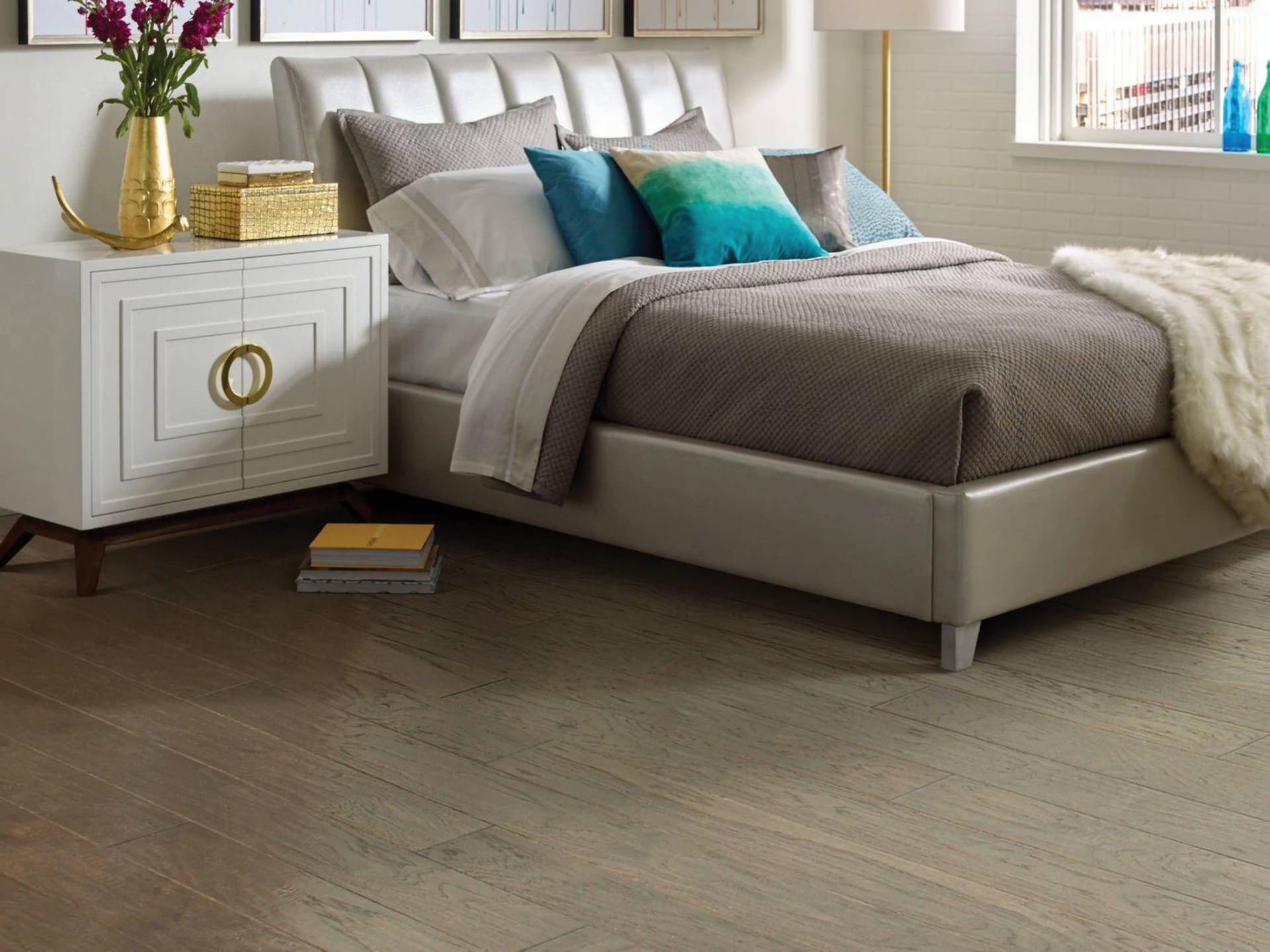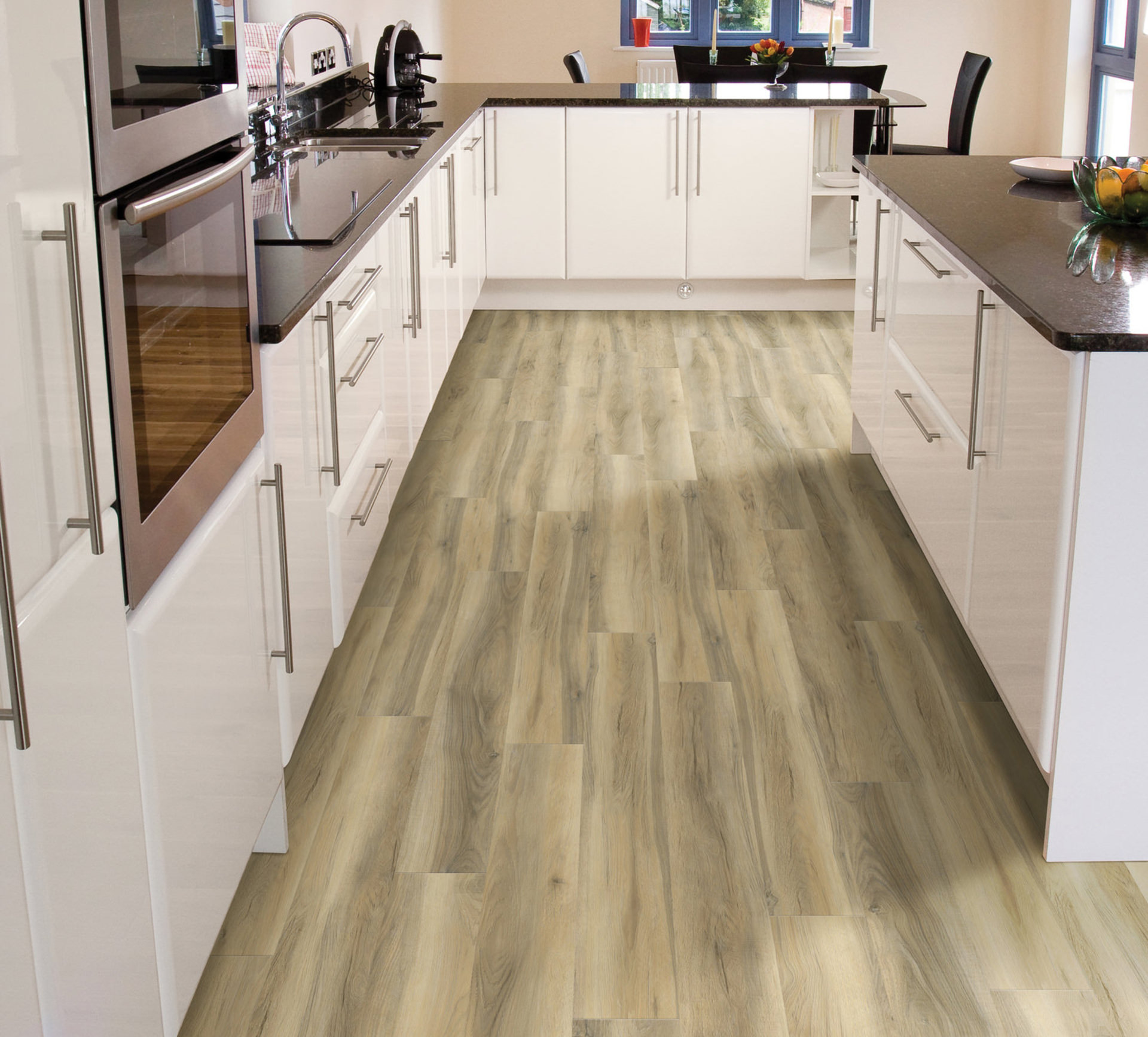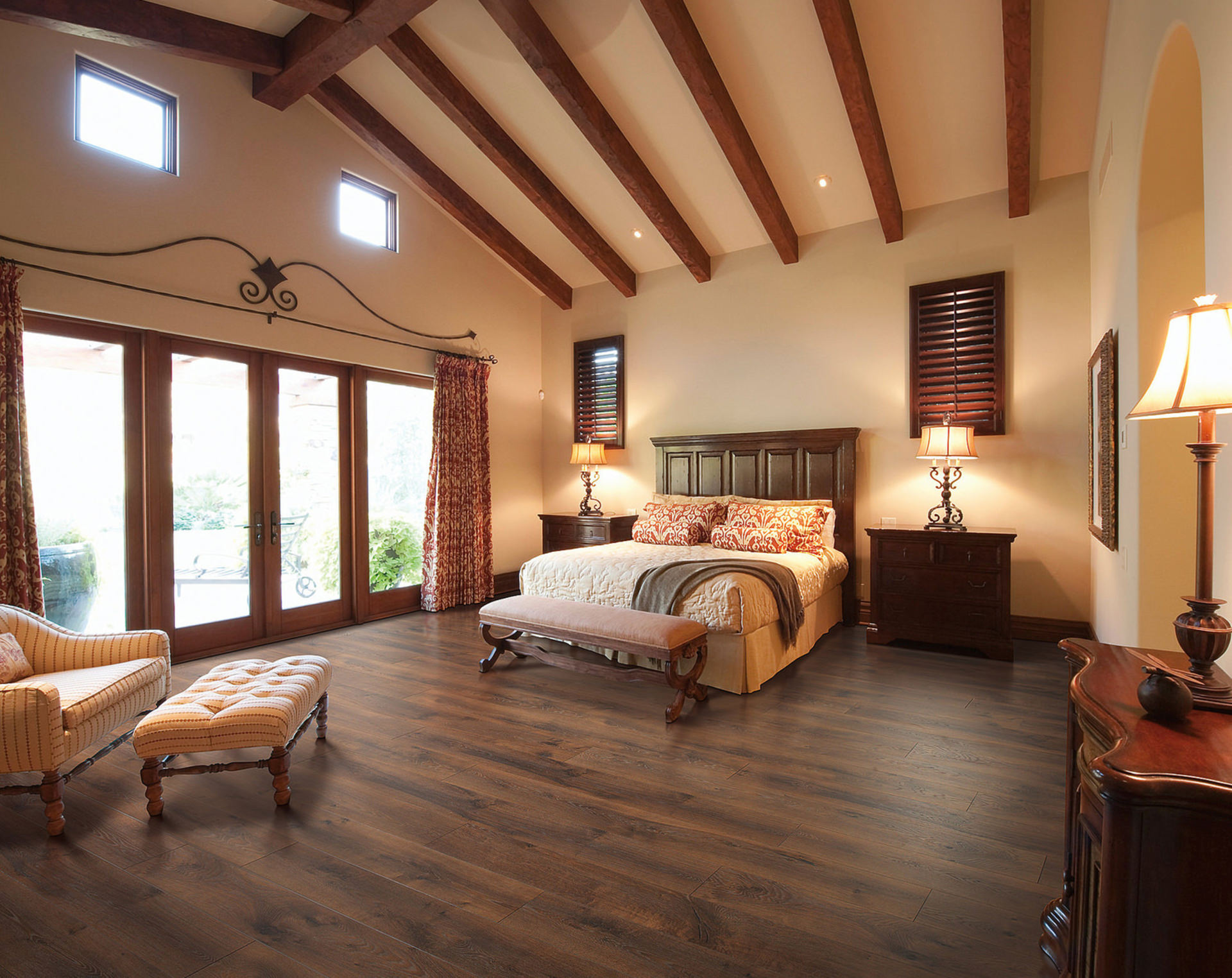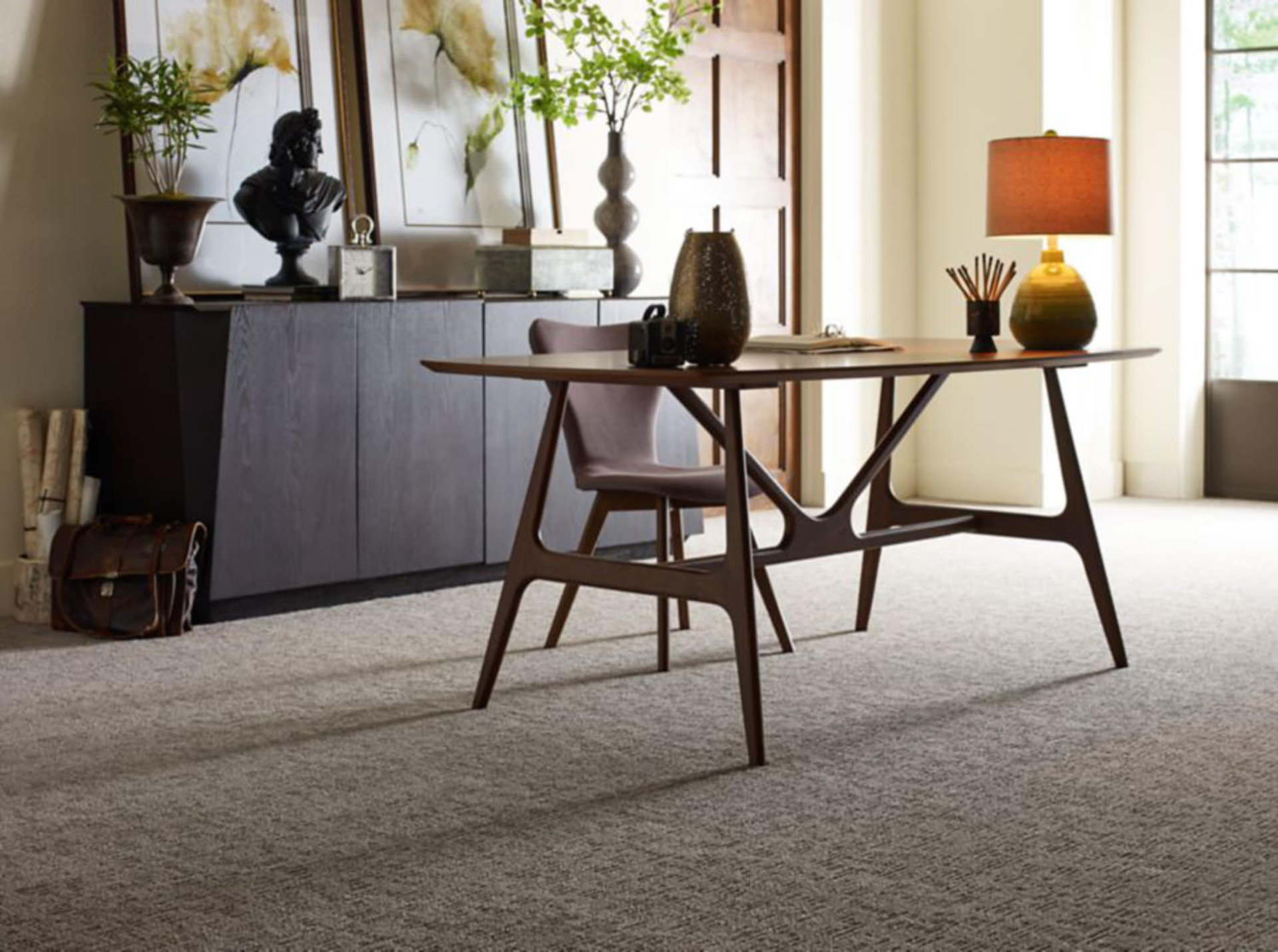Flooring Buying Guide

One of the best ways to brighten a home is to replace the flooring. If your carpet is worn or your solid flooring is dented and scratched, a change may be just the ticket to give your home a new ambiance. Or maybe your flooring is dated, and you’ve taken an interest in the lighter and cleaner look that has become so popular.
A new floor can not only lift your spirits but also increase your home’s value. Whether you choose hardwood, luxury vinyl, laminate or carpeting, here are some key factors to consider.
The Classic: Hardwood
For some people, only hardwood floors will do. Their beauty is unsurpassed. Hardwood lasts for decades and, depending on the product, can be refinished again and again. On the other hand, it’s expensive and requires ongoing care. It scratches and dents easily, and water damages it.
Light shades, especially white oak, are increasingly popular. Whitish colors open up small rooms and make them look larger. These paler floors look wonderful with contemporary furnishings. And a light floor is a must if you’re going for a coastal look.
Matte is an option to consider if you’re going light. The low sheen not only makes for a natural look but also has a comfortable underfoot feel.
Still, there’s plenty of interest in more traditional darker colors. They lend an elegant and sophisticated air. Some flooring is stained to achieve something darker than the wood’s natural shade. The result might be as deep as a chocolate brown or a brown that almost looks black.
Oak and hickory are can’t-miss options for flooring woods, but you’ll also find variants such as maple and cherry.

The New Best-Seller: Luxury Vinyl Flooring
Luxury vinyl is finding its way into more and more homes every year, and there are plenty of reasons why. It has the appearance of hardwood at a considerably lower cost. It’s durable, and it’s a cinch to take care of. Professional installation is reasonably priced, and a handy homeowner can often DIY.
Vinyl is waterproof and can be used in every room in the home, including kitchens and bathrooms. It doesn’t dent easily. It resists spills and is easily cleaned, making it a favorite for households with children and pets.
Most vinyl is in the form of luxury vinyl plank (LVP), which comes in planks that imitate a hardwood floor. Large planks, some as big as ten by 84 inches, are a top choice because they make a room look larger and airier. They come in multiple patterns but are frequently designed to imitate real wood with grains and knots. Some planks have painted beveled edges; they emphasize the borders between the pieces.
There’s also luxury vinyl tile (LVT). As the name suggests, the pieces are smaller, and the patterns often imitate porcelain or ceramic tile or even stone.
Lots of luxury vinyl is on the market, and quality varies. It’s good to understand what to look for in the tile’s construction.
Luxury vinyl has several layers. The pattern you see is not on the surface but in the second layer. It’s a high-definition digitally imprinted paper. A clear wear layer sits on top of that, and that’s what protects the pattern.
The thicker the wear layer, the more the protection. These layers are measured in thousands of an inch, or mils. Most residential vinyl has a wear layer of 8 – 12 mils, and 20 mils is better for high-traffic areas.
The thickest part of the plank is the core. The standard core has been wood-plastic composite (WPC). A more recent option is stone-plastic composite (SPC), which is stronger and can be manufactured thinner. Most people find that WPC is still more comfortable for walking.
Many products have an underlayment layer made of cork or foam, which provides an extra degree of underfoot cushioning.
Total plank thickness is measured not in mils but in millimeters. The best WPC vinyl is 8 mm or thicker, while SPC runs 5 – 7 mm thick.

Versatile Laminate
The continuing improvement in laminate is one of great stories in interior flooring, and homeowners and designers are starting to catch on. This isn’t the laminate of yesteryear; this is quality flooring composed of individual planks, and it rivals luxury vinyl in appearance and durability.
Laminate is water resistant, and its water-repelling ability gets better all the time. Laminate can stand up to spills and wet feet, but it’s not waterproof like vinyl and therefore not suitable for kitchens and bathrooms. On the other hand, it resists denting and scratching better than luxury vinyl.
Laminate flooring is actually made from wood. There’s a thin melamine layer covering a wood fiber core. The image layers of laminate do an amazing job of imitating natural wood with various bevels and textures. Much laminate is imaged to look like woods such as oak, maple, pine, cherry and hickory.
This flooring option is available in multiple colors, but, as with other flooring, off-whites, beiges, light browns and grays continue to be among the most popular.
You can have your choice of textures. Many laminate floors have a flat texture, but there’s also a wood-grain look and feel, and an embossed texture with ridges that look like worn wood. There’s even a wood scraped look suitable for rooms with a rustic style.
Today’s laminate is attractive, durable, comfortable underfoot, easy to install and a snap to maintain. All of that comes at an attractive price point well below that of hardwood.

Worth A Fresh Look: Carpet
With all the developments in hard flooring over recent years, carpeting has sometimes been overlooked. However, designers are rediscovering the wonderful attributes of this floor covering. The best carpet has kept up with the times and has as much to offer as its alternatives.
Nothing rivals carpet in comfort. It’s a lot easier to swing your feet out of bed in the morning when you know they’re going to land on a plush carpet. In cold weather, carpet not only feels warm, but also insulates and helps contain heating costs. Because of its warmth, carpet is a great choice for basements. It insulates sound as well, softening footsteps and even noise from TVs and stereos.
There’s the safety factor. Socks and slippers won’t slip and slide. If someone does take a tumble, carpet is a better place to land than a hard floor. Carpeting is more comfortable for children to play on, and also for grown-ups to get down there with them. While maintenance might not be as easy for carpeting as for vinyl and laminate, many modern carpets are stain-resistant and water-repellent.
The variety of colors and style in carpeting is endless. They can set the tone for a room or match what’s already there. Carpet comes at a wide variety of price points, many of them more affordable than the hard flooring options.
Carpet is constructed with either a looped pile or cut pile. Looped pile carpeting is made up of small loops of fiber attached to backing. Low looped pile carpeting is ideal for high-traffic areas. It keeps foot tracks and vacuum marks to a minimum. Some looped pile carpeting has varying pile heights for a sculpted look. One drawback to looped pile is that it can be snagged by pet claws and other pointy objects.
With the other choice, cut pile carpeting, the loops are cut at the top, which makes them dense and softer. They are more likely to crush or mat than a looped pile. They’re also more subject to staining and harder to clean. As with looped pile, the pile height is sometimes varied for a textured look.
Several materials are commonly used in carpet fiber. Nylon is durable and can be treated for stain resistance. You’ll find nylon in the entire range of cost and quality, but the top-quality carpets have a higher weight and density.
Polyester fibers are not as durable as other fibers like nylon, but they resist mold and moisture, which makes them a top choice for basements.
Not all carpet fibers are synthetic, and, in this era of environmental consciousness, natural fibers are the choice of many. A favorite natural material is wool; few things are as soft and luxurious.
Carpets are subject to staining, but there are stain repellents that can keep them from deteriorating into a worn look. You can protect your investments from soiling by pets or careless people with products such as Smartstrand or R2X.
A final note: don’t forget the carpet cushion. A quality carpet cushion not only extends the life of your investment but also provides more comfort in walking and increases the insulating and soundproofing factor.

The Best Flooring Choice for You
There’s a lot to consider when you shop for flooring. You want a flooring that fits your budget, appeals with its appearance and complements your lifestyle. With all the terrific choices available today, you’re sure to find several that will work nicely in your home. Use your fashion sense and some of these tips to select the flooring that’s perfect for you.